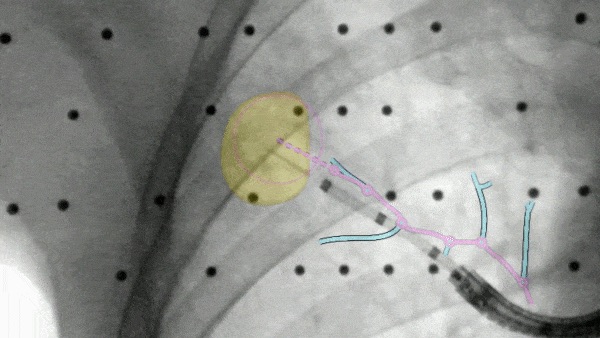
When radiologic imaging reveals a spot on the lung that physicians suspect may be lung cancer, a tissue biopsy is required to obtain a definitive diagnosis. Endobronchial biopsies are acquired by advancing a bronchoscope into the lung and navigating endoscopic tools to the lesion through the bronchoscope working channel. Unlike lesions located in areas such as the stomach or colon, a lesion in the periphery of the lungs does not always have a clear, known or even visible pathway. A physician must advance a bronchoscope through the trachea into the lungs, where a complex network of airways branching into smaller airways presents very difficult challenges: inability to localize the bronchial lesion inside the lung, as well as the mechanical limitation to maneuver tools inside the lung and physically reach the lesion or area of interest.
Although the physician has access to preoperative CT and intraoperative ultrasound imaging in the procedure room, there has not been a practical technology for real-time navigation of the lungs’ complex structure utilizing this invaluable information. In essence, the physician knows the general anatomic area where a suspicious lesion is located in the lung, but it is difficult to tell if the bronchoscope is being guided to the correct position to obtain a diagnostic sample.
Electromagnetic navigational bronchoscopy (ENB), has improved this procedure. It offers virtual GPS-type guidance over a previously acquired CT scan, using a locatable guide with a tiny electromagnetic sensor at the tip to direct the physician to the area of interest.
Recognizing the promise of current ENB systems to diagnose and treat solitary pulmonary nodules, we understand they provide only a partial solution. Current systems have several technical and performance limitations, high utilization and maintenance costs, lack of integration with existing technologies and tools, and long learning curve. Body Vision Medical has developed the Lung Vision solution which addresses these limitations. The LungVision solution is a suite of proprietary devices, software and tools that is designed to reach suspicious nodules in the deep periphery of the lungs accurately and reliably in real time. LungVision provides seamless utilization and integration with a variety of existing of-the-shelf operational tools and imaging modalities.
LungVision has the potential to revolutionize navigational bronchoscopy by dramatically enhancing localization and expanding bronchoscopic visualization beyond the limits of the airway walls. Using leading-edge machine learning, multimodal registration and augmented real-time
imaging algorithms, LungVision technology merges intraoperative imaging with preoperative imaging, providing valuable information at the time it is needed. This allows physicians to plan, visualize, and track the position of endobronchial tools and the location of radiolucent lesions in real time. Conventional bronchoscopic procedures upgraded by LungVision can achieve several important goals for physicians and their patients with suspected lung cancer:
Successful acquisition of a biopsy
With real-time navigation, physicians are more likely to obtain the diagnostic sample of tissue that will allow a pathologist to diagnose or rule out lung cancer.
Increased biopsy accessibility
When a lesion of indeterminate nature is detected, patients and their physicians must decide whether to have a biopsy or follow with imaging over time. Knowing that patients will get a definitive answer with LungVision makes biopsy an easier choice.
Reduced wait time for treatment
Some cancers exhibit early symptoms or are detected in routine screenings, but lung cancer often does not have symptoms until later in the disease process. As a result, for about 40% of patients, the disease is not detected until it reaches its advanced stages. Immediate treatment can improve survival. LungVision speeds diagnosis, which in turn allows patients to be treated more quickly.
Decrease in unnecessary surgery
Surgery for lung cancer is deeply invasive, causing significant pain and hospitalization. Today patients can undergo surgery, only to learn that their lesion was benign. By making it easier to obtain an accurate biopsy, LungVision decreases the number of patients who will have unnecessary surgery.
Timely treatment
Some patients with early-stage lung cancer exhibit symptoms, but lung cancer patients often do not have symptoms until later in the disease process. Detection in routine screenings is possible, and CT screening guidelines were recently introduced. However, approximately 40% of patients will be diagnosed with lung cancer at an advanced stage. Immediate diagnosis and treatment for malignant lesions may improve their life expectancy.
Fewer deaths from lung cancer
Worldwide, about 1.35 million people are diagnosed with lung cancer every year; 1.18 million die. This terrible disease has the highest death rate of all cancers. Ultimately, the goal of the Body Vision system is to change that. By raising the level of precision and accessibility of biopsies with LungVision, Body Vision is taking an important step in that direction.